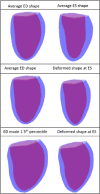Atlas-Based Computational Analysis of Heart Shape and Function in Congenital Heart Disease
- PMID: 29294215
- PMCID: PMC5910190
- DOI: 10.1007/s12265-017-9778-5
Atlas-Based Computational Analysis of Heart Shape and Function in Congenital Heart Disease
Abstract
Approximately 1% of all babies are born with some form of congenital heart defect. Many serious forms of CHD can now be surgically corrected after birth, which has led to improved survival into adulthood. However, many patients require serial monitoring to evaluate progression of heart failure and determine timing of interventions. Accurate multidimensional quantification of regional heart shape and function is required for characterizing these patients. A computational atlas of single ventricle and biventricular heart shape and function enables quantification of remodeling in terms of z scores in relation to specific reference populations. Progression of disease can then be monitored effectively by longitudinal evaluation of z scores. A biomechanical analysis of cardiac function in relation to population variation enables investigation of the underlying mechanisms for developing pathology. Here, we summarize recent progress in this field, with examples in single ventricle and biventricular congenital pathologies.
Keywords: Atlas-based analysis; Congenital heart disease; Patient-specific modeling.
Conflict of interest statement
ADM and JHO are a co-founders of, and have an equity interest in Insilicomed, Inc., and serve on the scientific advisory board. ADM is a co-founder of Vektor Medical, Inc., and serves on the scientific advisory board. Some of their research grants, including those acknowledged here, have been identified for conflict of interest management based on the overall scope of the project and its potential benefit to Insilicomed, Inc. The authors are required to disclose this relationship in publications acknowledging the grant support, however the research subject and findings reported here did not involve the company in any way and have no relationship whatsoever to the business activities or scientific interests of the company. The terms of this arrangement have been reviewed and approved by the University of California San Diego in accordance with its conflict of interest policies. The other authors have no competing interests to declare.
Figures






References
-
- Marelli AJ, Mackie AS, Ionescu-Ittu R, Rahme E, Pilote L. Congenital heart disease in the general population: changing prevalence and age distribution. Circulation. 2007;115(2):163–172. doi:CIRCULATIONAHA.106.627224 [pii] - PubMed
Publication types
MeSH terms
Grants and funding
LinkOut - more resources
Full Text Sources
Other Literature Sources
Medical

